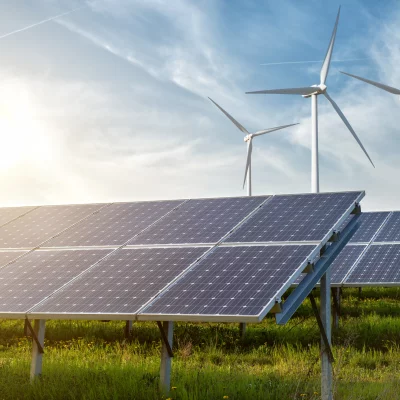Our energy future - hydrogen as the key to the energy transition


The restructuring of our energy system is absolutely essential to protect our climate. Alongside renewable energies such as wind and solar energy, green hydrogen is seen as the key to a successful energy transition. In order to actively drive forward the energy transition, the intelligent production of green hydrogen from wind power as well as its storage, transport, marketing and utilisation is being tested on a large scale for the first time in Central Germany at the Bad Lauchstädt Energy Park. As a real-life laboratory for the energy transition, the Bad Lauchstädt Energy Park is making a proactive contribution to shaping our climate-neutral energy future and innovation-driven structural change in the Central Germany region.
Why do we need an energy transition?
With the Paris Climate Agreement, which was adopted at the UN Climate Change Conference in Paris in 2015, 195 countries committed to the goal of curbing climate change and limiting the global temperature rise to 1.5 degrees Celsius if possible, but in any case to well below two degrees Celsius compared to the pre-industrial age. Global warming of just 2 degrees Celsius would lead – just to name a few of the effects – to a massive rise in sea levels and increasingly frequent and severe extreme weather events such as heatwaves, drought and flooding as a result of heavy rainfall.
In Germany, too, the effects of climate change, which are already felt today, will be significantly intensified. To prevent this, the global economy must be decarbonised quickly and consistently, i.e. it must generate less harmful carbon dioxide as soon as possible. The Federal Republic of Germany also wants to make its contribution to achieving the targets set in the Paris Climate Agreement. Germany’s long-term goal is to achieve climate neutrality by 2050. By 2030, greenhouse gas emissions in Germany are to be reduced by at least 55 per cent compared to 1990 levels.
In order to achieve these goals, we must switch to renewable energy sources such as hydroelectricity, solar and wind energy as quickly as possible, both for the electricity sector and for heating and transport. Fossil fuels such as coal, oil and natural gas must be completely replaced by renewable energies in the long term due to their harmful effects on the climate.

Green hydrogen is part of the solution
The essential switch from fossil fuels to renewable energies brings with it new challenges, particularly in terms of security of supply. For example, the availability of wind and solar energy fluctuates. Because when the sun is not shining and the wind is not blowing, neither solar nor wind energy can be generated. In addition, the electricity generated from renewable energies cannot easily be stored in large quantities or for the long term, but must be fed directly into the electricity grid and consumed.
The limited short-term storage capacity (usually batteries) can only cover periods of minutes at best. Without storage options, this could also mean that no electricity is available when it is needed.
And this is precisely where green hydrogen comes into play, as it offers the possibility of storing electricity from renewable energies in the long term, transporting this energy easily and utilising it effectively. In this way, renewable energies can be integrated into the energy system and also exploited by particularly energy-intensive sectors such as the chemical and steel industries. The conversion of renewable energies into green hydrogen, which takes place in “power-to-gas” plants, is regarded as a key element in intersectoral energy integration- the integration of individual, otherwise separate areas of energy supply: Electricity, heat and mobility. Green hydrogen can therefore make a significant contribution to climate protection. As a versatile energy source, it offers the possibility of environmentally friendly redesign of the industrial, transport and heating sectors, which are otherwise particularly detrimental to the climate, and will therefore play a key role in the successful implementation of the energy transition.
Characteristics of green hydrogen
- Generation with renewable electricity
- Environmentally friendly and climate-neutral
- Easy to store
- Compensates for fluctuations in solar and wind power
- Wide range of applications
Green hydrogen for the Central Germany region
The Bad Lauchstädt Energy Park is located between Teutschental and Bad Lauchstädt, in the Saale district of Saxony-Anhalt, in the centre of the Central German mining district. The energy transition and the associated phase-out of coal-fired power generation pose major structural challenges for the region. This is because the coal phase-out means that a significant proportion of the added value and tax revenue from conventional energy supply will be lost to the region, and with it the jobs that come with this sector.
To overcome these challenges, the government of the federal state of Saxony-Anhalt has presented a structural development programme for the Central German mining district of Saxony-Anhalt (SEP) in 2021. The policy paper shows how innovation-driven structural change can succeed in the Saxony-Anhalt section of the Central German mining area. A key aspect of maintaining and expanding value creation and employment in this region is the development of a hydrogen economy (see also hydrogen strategy). The Bad Lauchstädt Energy Park plays a key role in this development and also creates new jobs in the region’s energy industry. As an innovation-driven project, the Bad Lauchstädt Energy Park also serves as a template for the development and implementation of similar concepts in other regions affected by transformation processes.

